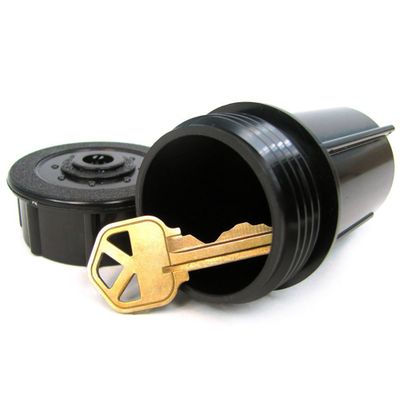Safely hide a spare key (for nonburglars’ eyes)

It’s a horrible feeling: You arrive home and discover that you lost your key. If only you had a spare you could use to gain entry. Actually, there are numerous ways to hide that spare key.
Let’s get the obvious ones – and by obvious we mean dumb – out of the way.
Don’t leave a spare key under the doormat. Even the most dim-witted criminal will check under the mat. You’ve seen those artificial rocks. So have burglars. Forget them. Put it up over the door frame? C’mon, you can be more inventive than that. There are better solutions to the lost-key conundrum:
Lockbox: You’ve seen real estate agents use them. They are small secure containers that can be opened by punching in a code. They come in various sizes and strengths. Real estate people attach them to the front-door knob. Don’t be so obvious. Hide it somewhere on the property, in a location where it can’t be seen from the street and not in close proximity to the lock. You’re telling a burglar, “Hey, Goober, there’s a key inside, and it’ll open this here door.”
Good disguises: If you have in-ground sprinklers, there’s a dummy sprinkler head that blends in with the others and can hold a key ($7.95). Similarly, there’s a working thermometer that has a hidden compartment where a key may be stashed ($6.95). Both are available at thehomesecuritysuperstore.com .
Out of sight: The website besthomesecuritycompanys.com suggests hiding the spare key out of street view – a criminally inclined passer-by could see you retrieve it and come back later to use it himself. It also suggests hiding the key around back - and make it a key to a back or side door.
The neighbors: If you have a trusted neighbor, ask them to hold on to a spare key. You can reclaim it if you get locked out, or they can let themselves in should an emergency arise while you are away. Just be sure the neighbor is dependable and doesn’t have a ne’er-do-well teenager who might take advantage of the opportunity.
On the property: There are likely several hiding places just a few steps from your door. Duct tape a key to the leg of your grill, to the underside of your mailbox or inside the bird bath pedestal. Bury one under the seed in your bird feeder, or plant it under the potted impatiens on the porch. Want to get more razzly dazzly? Glue a small magnet to your key, and attach it to the inside of your home’s downspout extension.
Up a tree: Take a spare key and nail it to a tree. It could be on your property, or maybe it’s down the street a block or two. Nail it up in an inconspicuous location on the tree, somewhere that’s out of plain view and requires some searching to find. When you stash the key away from your property, anyone coming across it by chance will have to try a whole neighborhood of doors. Just remember which tree the key is hidden in.
The doghouse: No dog should be made to live outside. But for the times little Gumpy is out running around in the yard, you should provide him with a shelter. Inside that doghouse is a good location to hide a key. Heck, even if you don’t have a dog, get a small doghouse and hang the key inside. Just seeing a doghouse will give a would-be burglar pause.
Wind chimes: Several websites suggest hiding a key inside a set of wind chimes. Even if a prospective thief knew the key was there, he’d have to make a lot of noise getting it out. No criminal wants that. And if you really want to mess with the guy, hang a whole keyring of multicolored keys in the wind chimes. Not only would he make noise with the chimes, he’d also have to figure out which key opened the door. (You would know it’s the blue one, or the red one, etc.) If there’s one thing burglars hate more than making noise, it’s standing on a porch fiddling with a ring of keys.